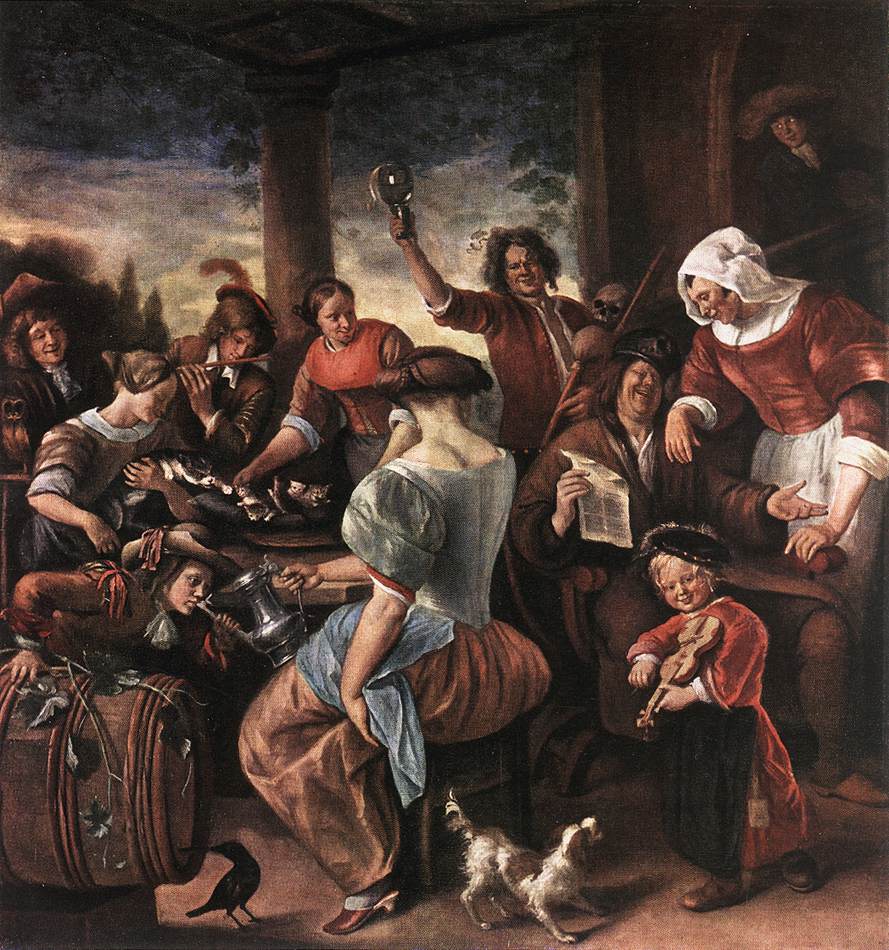|
|
|
|
home
|
|
STEEN, Jan/ ARTISTS
1650-1899/ ART MAIN
|
film and food
|
|
(b.
1626, Leiden, d. 1679, Leiden)
|
literature and
food
|
|
Dutch painter. He is best
known for his humorous genre scenes, warm hearted and animated works in
which he treats life as a vast comedy of manners. In Holland he ranks
next to Rembrandt, Vermeer, and Hals in popularity and a ‘Jan Steen
household’ has become an epithet for an untidy house. But Steen, one of
the most prolific Dutch artists, has many other faces. He painted
portraits, historical, mythological, and religious subjects (he was a
Catholic), and the animals, birds, and still-lifes in his pictures rival
those by any specialist contemporaries. As a painter of children he was
unsurpassed.
Steen was born in Leiden
and is said to have studied with Adriaen van Ostade in Haarlem and Jan
van Goyen (who became his father-in-law) in The Hague. He worked in
various towns – Leiden, The Hague, Delft, Warmond, and Haarlem – and in
1672 he opened a tavern in Leiden. His father had been a brewer, and in
the popular imagination Steen was a drunken profligate, but there is
nothing in the known facts to justify this reputation. Many of his
pictures represent taverns and festive gatherings, but they often
feature moralizing allusions, and he also painted scenes of impeccable
genteelness. Apart from his versatility, richness of characterization,
and inventiveness in composition, Steen is remarkable also for his skill
as a colourist, his handling of salmon-red, rose, pale yellow, and
blue-green being highly distinctive.
He had no recorded
pupils, but his work was widely imitated.
|
music
and food
|
|
photography and food |
|
|

|
|
A Merry Party
c. 1660
Oil on canvas, 150 x 148 cm
Museum of Fine Arts, Budapest
|
|
|
|
|
Jan Steen was one of the
most popular of the Dutch masters of the seventeenth century. His gay
and animated genre-scenes were highly appreciated, both by his
contemporaries and by collectors in the eigtheenth and nineteenth
centuries. He was a pupil of Nicolaus Knüpfer in Utrecht and of his
father-in-law, Jan van Goyen, and lived and worked for varying periods
of time in nearly every large town in Holland.
His range of subjects was
extremely wide; he painted both villages and towns, peasants and
well-to-do citizens; his vividly coloured, broadly constructed
compositions depict taverns, sick-rooms, fairs, workshops and weddings,
mythological and historical scenes in the spirit of the Dutch oratorical
groups of his time, as well as character figures and a few portraits.
Steen often depicted his
family and himself, as indeed he has done in this picture, where he, his
wife and his children are seen carousing. The work gets its alternative
title of "The Cat Family" from the basket of new-born kittens
held by the girl at the back of the circle.
This picture splendidly
summarizes the art of Steen – and Dutch genre as a whole. The centre of
the family circle is the cat family in the basket on the table.
Everybody is happy, gay and completely relaxed. The artist indicates our
senses as the main source of pleasure: hearing makes us enjoy music; the
sense of touch enables us to enjoy stroking the cats; the sense of taste
and smell are satisfied by drinking; and our sight conveys the delight
of reading an amusing story. The latter joy is represented by the figure
of the artist himself, for the reader is a self portrait. The pleasing
figure of a woman seen with her back to the onlooker could be the
pleasure-giving muse of genre painting-if genre painting ever had such a
muse. And if there were no such muse, then she must be considered to be
Steen’s most captivating figure of a woman, whose face, however, was
apparently not worthy of the painter’s brush.
|
|
|
|